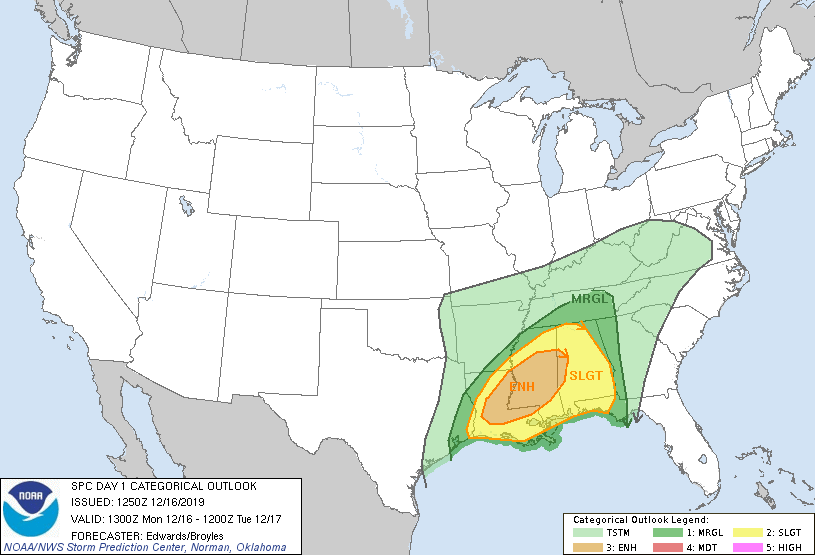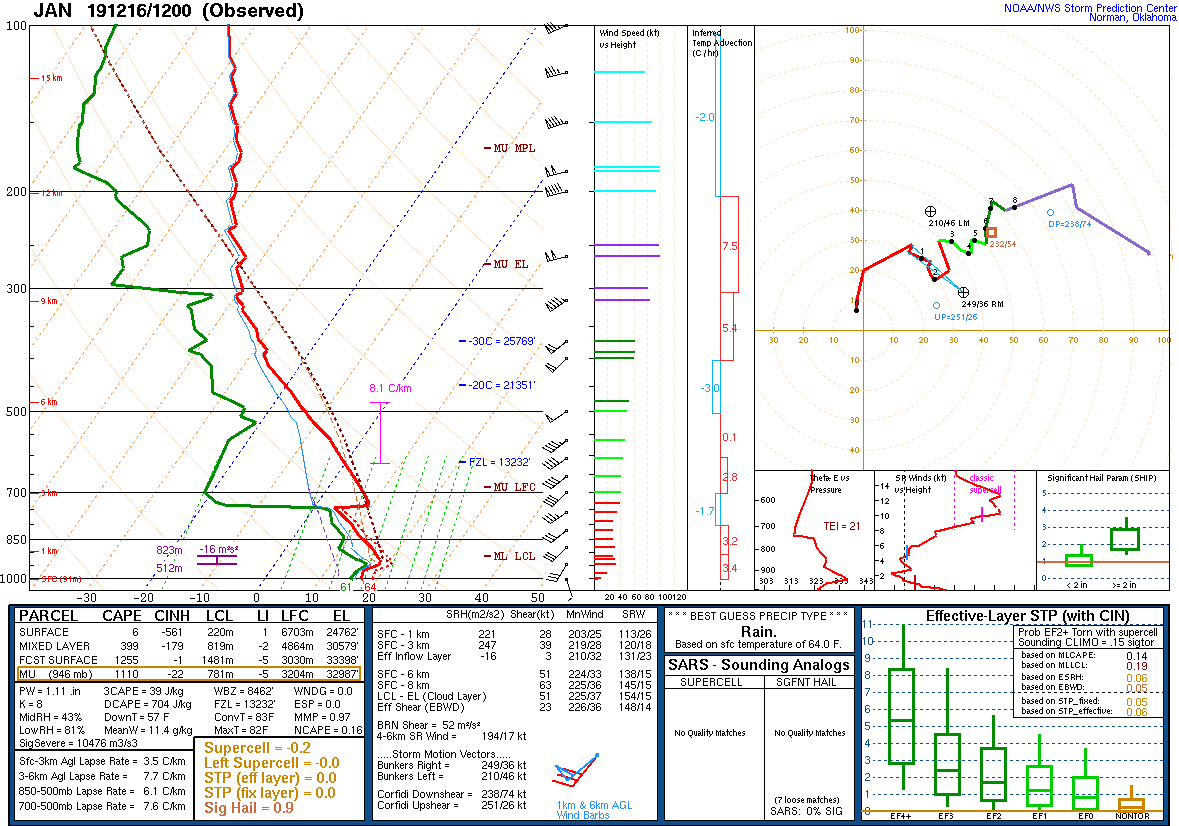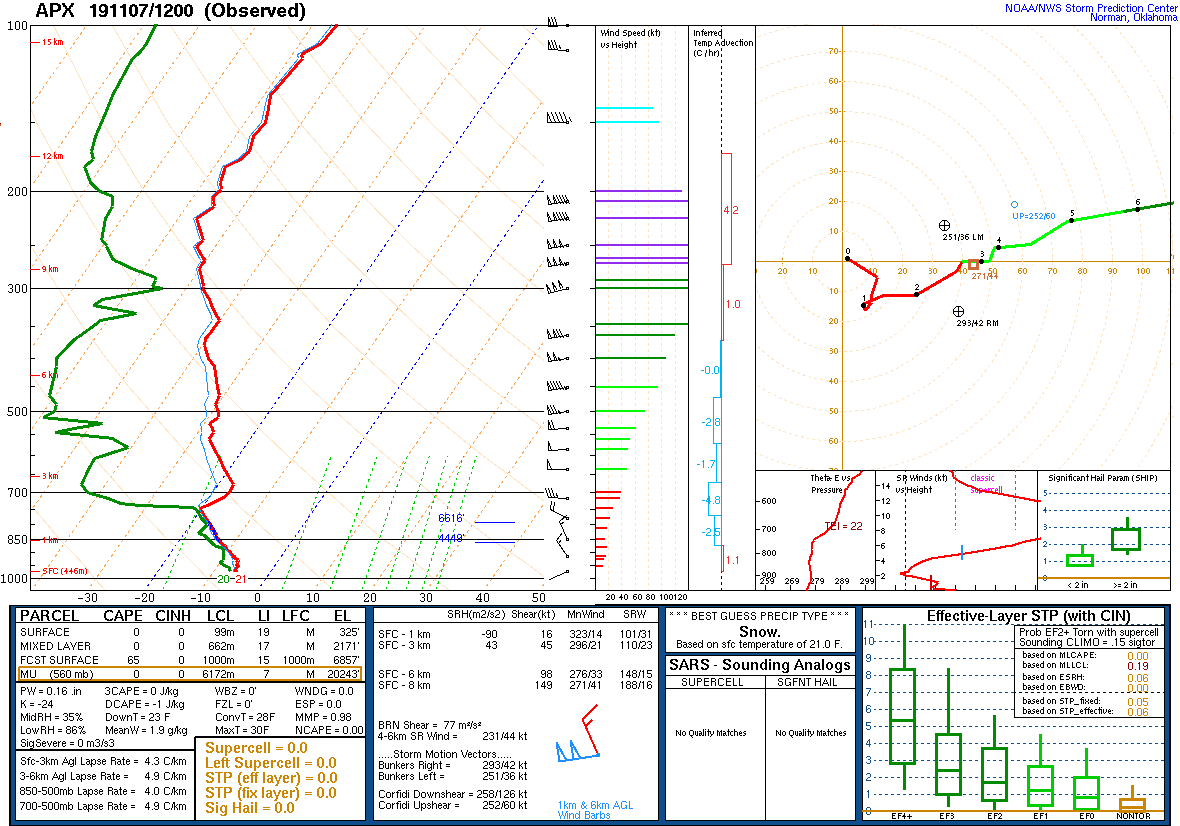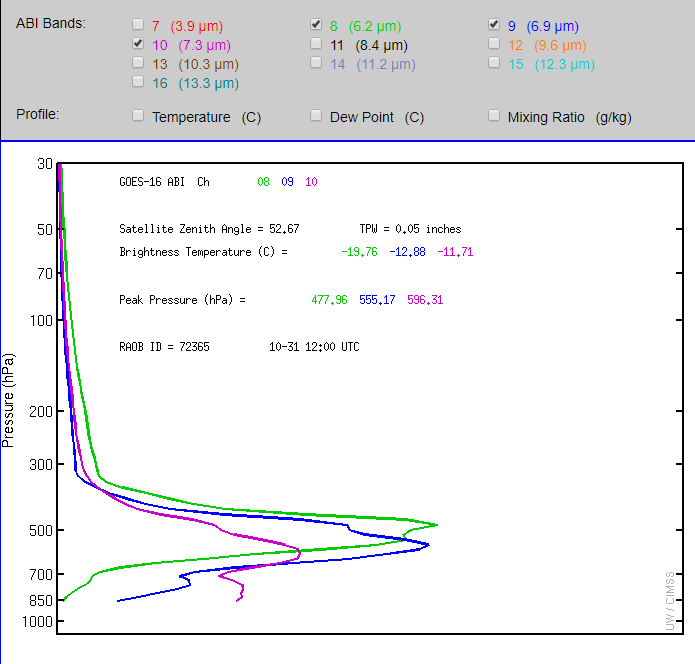Snow Squalls in Pennsylvania on 8 January 2020
January 8th, 2020 by Dan BikosBy Dan Bikos and Bill Line
On 8 January 2020 numerous snow squalls moved across Pennsylvania leading to the issuance of multiple snow squall warnings by the NWS. One of the challenges with this event is that it spanned the time period around sunrise. Obviously radar and IR satellite imagery is not affected by this, but the Day Cloud Phase Distinction RGB, which has been shown to be quite useful for snow squall events, can only be used during the daytime. One alternative to continue monitoring during this time period is to make use of the nighttime microphysics RGB at night. This RGB product makes use of the 10.3 minus 3.9 micron band difference for the green component which discriminates between water (positive) and ice (negative) clouds at night.
The following 4 panel GOES-16 loop:
Upper-left: Nighttime Microphysics RGB
Upper-right: Daytime Cloud Phase Distinction RGB
Lower-left: MRMS 1-km composite reflectivity
Lower right: IR (10.3 micron) band with METARs
First look at the Daytime Cloud Phase Distinction RGB in the upper-right, later in the loop when there is daylight this product does a good job in delineating which clouds are glaciated (green and also orange/red shades) versus water clouds (cyan/lavendar). Compare the cloud tops that are glaciated with MRMS reflectivity and we see that there is good agreement in delineating the more intense snow squalls from the less intense regions of snow.
Now trace backwards in time these glaciated clouds through the sunrise period into the overnight hours and notice how they appear in the nighttime microphyics RGB in the upper-left. The glaciated clouds appear tan to darker shades of red and also correspond pretty well with regions of higher reflectivity observed from MRMS.
We include IR imagery (with METARs) to illustrate only a loose correspondence between colder cloud tops and higher regions of reflectivity, the RGB products definitely do a better job since they can delineate ice versus water cloud tops.
Next, we’ll focus in on a modified Day Cloud Phase Distinction RGB product that allows you to see further towards the nighttime hours compared to the default product:
Upper-left: Nighttime Microphysics RGB
Upper-right: Modified Daytime Cloud Phase Distinction RGB
Lower-left: MRMS 1-km composite reflectivity
Lower right: IR (10.3 micron) band with METARs and GLM Flash Extent Density
The modifications to the Daytime Cloud Phase Distinction RGB are the same as shown in this blog entry.
Compare the modified Daytime Cloud Phase Distinction RGB to the default in the previous loop and notice that you get more images towards the nighttime hours around sunrise.
We included the GLM Flash Extent Density data as an overlay in the lower-right panel, note that there was some lightning activity associated with some of the snow squalls which further increases confidence that these were high-impact snow squalls.
A social media post illustrates the significant impacts of these snow squalls.
Later the same day during the early afternoon, a snow squall quickly moved through Philadelphia, prompting the issuance of a snow squall warning by the local NWS office. The Day Cloud Phase Distinction RGB at 1-min temporal resolution provides an alternative/supplement to radar imagery for tracking the precise evolution of the snow squall (see animation immediately below). Considering the environment in which we are viewing this RGB, the combination of convective cloud elements, cloud top glaciation, and rapid motion all apparent in the 1-min RGB imagery indicate snow squall potential with this feature.
Nearby surface observations measured wind gusts to 46 mph in associated with the snow squall, and photos on social media show the approach of the snow squall into Philadelphia.
Before and after a snow squall moved through Philadelphia this afternoon – as seen from the Comcast Technology Center. This line had a snow squall warning associated with it. Photo by @psumeteo alum Eric Mailloux. #snowsquall pic.twitter.com/BQ4uwZ0LfJ
— Weather World (@WeatherWorldPSU) January 8, 2020
Posted in: Winter Weather, | Comments closed
Elevated Mixed Layer event on 16 December 2019
December 16th, 2019 by Dan BikosOn 16 December 2019, SPC issued an enhanced risk of severe thunderstorms for portions of Louisiana and Mississippi:
One of the favorable ingredients for this severe weather setup was the presence of an Elevated Mixed Layer (EML) which is depicted in the 12Z Jackson, MS sounding:
The EML is bounded between the capping inversion around 750 mb and the higher RH around 500 mb. Within this layer, the relative humidity is quite low with a source region off the elevated plateau of northern Mexico. Lapse-rates within this layer are relatively high, 700-500 mb lapse rate is 7.6 degrees C / km and the maximum is shown in the magenta layer on the sounding of 8.1 degrees C / km.
At times, the EML may show itself as a region of warmer brightness temperatures in the GOES 7.3 micron imagery. In this particular case, the region of warmer brightness temperatures may be traced back to diurnal heating from the previous day over the elevated Mexican plateau and advecting northeastward across Texas, Louisiana and Mississippi:
Clouds develop during the early morning hours which obscure the EML signature, however it may still be tracked via the Advected Layer Precipitable Water (ALPW) product:
ALPW is a product based on microwave instruments aboard polar satellites which can see through most clouds. The 700-500 mb layer is useful in that it depicts the source region of the dry air associated with the EML and it can be tracked towards Mississippi. This dry air exists underneath a moist air mass with origins from the Gulf of Mexico as seen in ALPW in the lower layers. ALPW allows a four dimensional perspective of assessing moisture in the vertical in time.
More information on EML tracking via satellite imagery and products:
Posted in: Convection, Severe Weather, | Comments closed
Australian Wildfires
November 18th, 2019 by Jorel TorresNighttime visible imagery (i.e. Near-Constant Contrast or NCC) clearly shows the Australian wildfires that are raging and ablaze in New South Wales, a state in southeastern Australia. NCC detects emitted lights from the fires, and at times shows the fire perimeter lines and reflected light from the extensive smoke plumes. The animation below displays nightly Suomi-National Polar-orbiting Partnership (SNPP) NCC imagery between 13-15Z from 11-13 November 2019. Cloud cover and emitted city lights from Sydney and Brisbane can also be seen. The moon phase and moon elevation angle are depicted in the bottom-left corner. The full moon phase of the lunar cycle and positive moon elevation angle imply the moon was above the horizon and provided adequate moonlight to illuminate atmospheric features (i.e. an ideal time to view NCC).
The smoke from the fires can be accentuated further utilizing an NCC enhancement technique. The AWIPS NCC color table scale can be customized to bring out certain atmospheric features in the imagery. In the images below, the default NCC 0-1 enhancement is compared to the NCC 0-0.5 enhancement on 12 November 2019. Notice how the NCC 0-0.5 enhancement brings out the smoke from the fires along with nearby cloud cover, but increases the saturation of city lights in comparison to the NCC 0-1 enhancement. For interested users, this quick guide provides steps on how to apply different enhancements to NCC imagery.
But how can one differentiate between emitted lights from fires to the emitted city lights? Users can overlay NCC with VIIRS infrared 3.74µm to identify fire hotspots at 375-m spatial resolution. NCC and VIIRS IR imagery are observed at ~1430Z, 13 November 2019 below. Hotspots (i.e. high brightness temperatures) and outlines of fire perimeters coincide with certain emitted lights. The emitted lights from cities disappear when compared to the thermal infrared.
To get an idea of the atmospheric instability near the fires users can display NUCAPS soundings; polar-orbiting satellite derived soundings that are optimal in clear-sky environments, and where in-situ observations are poor or limited. The NUCAPS sounding that is picked for this event is circled in blue (see below), observed right over one of the fires. It shows a moderately unstable, dry environment conducive for fire initiation and fire spread, where precipitable water values (derived from the sounding) are 0.31 inches. Note NUCAPS soundings are overlaid onto NCC imagery on 14 November 2019. NCC imagery observes smoke advection towards the coastline.


Downwind of the fire, another NUCAPS sounding is observed near the coastline (see blue circle). NUCAPS depicts a shallow inversion indicating a stable environment. Sounding is predominately dry, albeit there is slightly more moisture observed near the surface; increased precipitable water values (i.e. 0.55 inches) could be due to maritime influences and/or ‘fire produced water vapor advection’ towards the coastline.


Posted in: Miscellaneous, | Comments closed
Lake-effect snow from 7 November 2019
November 7th, 2019 by Dan BikosGOES-16 imagery depicts lake-effect snowbands over the western Great Lakes on 7 November 2019:
Upper left: 0.64 micron visible band
Upper right: 10.3 micron IR band with default color table (IR_Color_Clouds_Winter)
Lower left: 10.3 micron IR band with GOES Snow Squall color table
Lower right: Day Cloud Phase Distinction RGB
The 0.64 micron visible band provides detailed information on the location of the band, but reflectance values do not provide information about the intensity of the band.
IR imagery at 10.3 microns provides cloud top brightness temperatures, however lake-effect snowbands are typically shallow so that the difference in a precipitating lake-effect band and non-precipitating band is small. The small difference may not even be easy to identify if the color table has insufficient contrast around those brightness temperatures, as we see in the IR imagery with the IR_Color_Clouds_Winter color table. The IR imagery with the GOES Snow Squall color table helps somewhat but does not provide information on glaciation like the next product.
Finally, the Day Cloud Phase Distinction RGB provides the most useful information at a glance for assessing lake-effect snowbands. Not only does it identify the location of the snowbands, but also indicates clouds that are glaciated versus clouds that are not glaciated due to the 1.6 micron band. In this RGB product, glaciated clouds have transitioned from light blue to green (and perhaps even yellow if more developed although not shown in this case). This allows one to identify clouds that have glaciated and thus much more likely to be producing precipitation, even heavier precipitation if conditions are favorable.
The sounding from Alpena, MI provides useful information about the environment:
The sounding supports lake-effect snow in the region with the deeper PBL and large low-level lapse rates under the capping inversion. Note the winds are northwest in this layer, indicating this airmass was modified by sensible and latent heat fluxes from Lakes Superior and Michigan.
Posted in: Lake Effects, Winter Weather, | Comments closed
Water vapor imagery in an extremely dry airmass – 31 October 2019
October 31st, 2019 by Dan BikosOn 31 October 2019 a very dry airmass existed over the southwest US. To illustrate the dry airmass, consider the sounding from Albuquerque, NM with a precipitable water amount of 0.05″ (1.27 mm):
The synoptic scale pattern was characterized by above normal PW in the east ahead of a trough, with below normal PW in the west behind the trough, as seen in the CIRA experimental TPW product:
This experimental product combines retrievals from both polar orbiting and GOES satellites. Contrast this with the current operational blended TPW product on AWIPS which uses only polar orbiting satellite data.
Next let’s consider the GOES water vapor bands, normally the upper 2 water vapor bands (at 6.9 and 6.2 microns) do not see all the way to the surface due to water vapor absorption. Recall that on occasion the low-level water vapor band at 7.3 microns may see to the surface depending on how dry it is. In this extremely dry airmass over elevated terrain, what do the GOES water vapor bands show?
Upper left panel: GOES-16 Water vapor band at 7.3 microns
Upper-right: GOES-16 Water vapor band at 6.9 microns
Lower-left: GOES-16 Water vapor band at 6.2 microns
Lower-right: GOES-16 GeoColor
Note that we observe clear skies across this scene in the GeoColor product.
In the 7.3 micron (low-level) water vapor band, we readily observe the earth’s surface as it warms with daytime heating. You can compare the terrain features seen in this imagery with what is shown in GeoColor. The warmest brightness temperatures are observed due to a combination of locally highest elevations and a relative minimum in TPW. In the 6.9 micron imagery we observe brightness temperature maxima where we see mountain peaks across various ranges, particularly in New Mexico. Even at 6.2 microns we observe indications of diurnal heating and warmer brightness temperatures along various peaks in New Mexico.
To help explain why the imagery sees all the way to the earth’s surface we analyze the weighting function profile from the Albuquerque sounding (courtesy of CIMSS – https://cimss.ssec.wisc.edu/goes/wf/):
Typically the weighting function profile for water vapor bands on GOES does not extend all the way to the surface, however due to the extremely dry airmass in place, the 7.3 and 6.9 micron bands have contributions from the earth’s surface. In fact, the 6.2 micron band even had contributions at elevations just above Albuquerque which explains why higher mountain peaks, which would be above 850 mb, are being observed in the 6.2 micron imagery.
The 1.38 micron “cirrus” band also is significantly affected by water vapor absorption, which is why this band is typically used to highlight cirrus clouds since the earth’s surface is generally not seen due to significant water vapor absorption. In this particular case with an extremely dry airmass, the earth’s surface shows up readily across the region of interest:
Posted in: GOES R, POES, Satellites, | Comments closed







